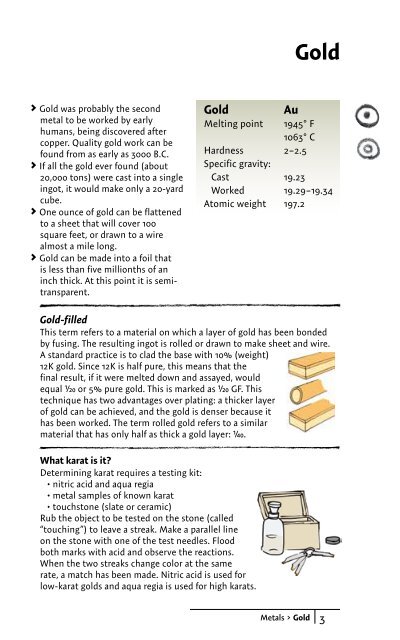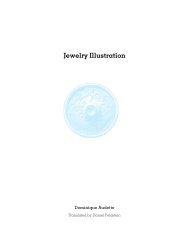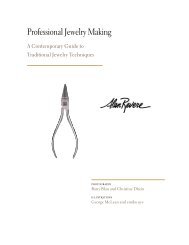complete metalsmith - Brynmorgen Press
complete metalsmith - Brynmorgen Press
complete metalsmith - Brynmorgen Press
You also want an ePaper? Increase the reach of your titles
YUMPU automatically turns print PDFs into web optimized ePapers that Google loves.
Gold was probably the second<br />
metal to be worked by early<br />
humans, being discovered after<br />
copper. Quality gold work can be<br />
found from as early as 3000 B.C.<br />
> If all the gold ever found (about<br />
20,000 tons) were cast into a single<br />
ingot, it would make only a 20-yard<br />
cube.<br />
> One ounce of gold can be flattened<br />
to a sheet that will cover 100<br />
square feet, or drawn to a wire<br />
almost a mile long.<br />
> Gold can be made into a foil that<br />
is less than five millionths of an<br />
inch thick. At this point it is semitransparent.<br />
Metals > Gold<br />
Gold<br />
Gold Au<br />
Melting point 1945° F<br />
1063° C<br />
Hardness 2–2.5<br />
Specific gravity:<br />
Cast 19.23<br />
Worked 19.29–19.34<br />
Atomic weight 197.2<br />
Gold-filled<br />
This term refers to a material on which a layer of gold has been bonded<br />
by fusing. The resulting ingot is rolled or drawn to make sheet and wire.<br />
A standard practice is to clad the base with 10% (weight)<br />
12K gold. Since 12K is half pure, this means that the<br />
final result, if it were melted down and assayed, would<br />
equal 1/20 or 5% pure gold. This is marked as 1/20 GF. This<br />
technique has two advantages over plating: a thicker layer<br />
of gold can be achieved, and the gold is denser because it<br />
has been worked. The term rolled gold refers to a similar<br />
material that has only half as thick a gold layer: 1/40.<br />
What karat is it?<br />
Determining karat requires a testing kit:<br />
• nitric acid and aqua regia<br />
• metal samples of known karat<br />
• touchstone (slate or ceramic)<br />
Rub the object to be tested on the stone (called<br />
“touching”) to leave a streak. Make a parallel line<br />
on the stone with one of the test needles. Flood<br />
both marks with acid and observe the reactions.<br />
When the two streaks change color at the same<br />
rate, a match has been made. Nitric acid is used for<br />
low-karat golds and aqua regia is used for high karats.<br />
3




